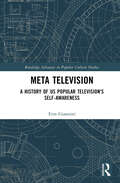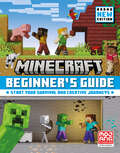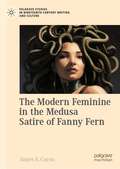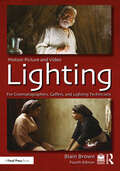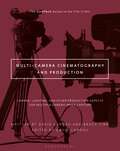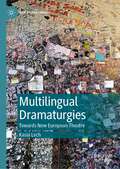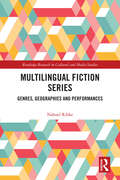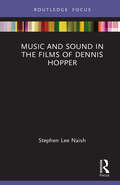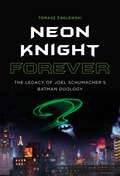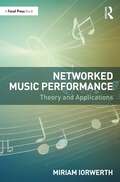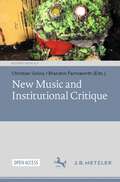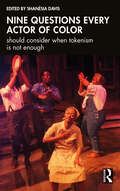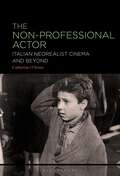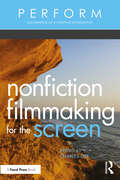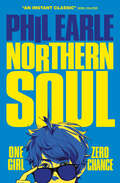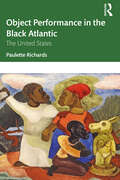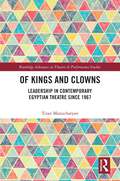- Table View
- List View
Meta Television: A History of US Popular Television's Self-Awareness (Routledge Advances in Popular Culture Studies)
by Erin GianniniThe idea of metatextuality is frequently framed as a recent television development and often paired with the idea that it represents genre exhaustion. US television, however, with its early “live” performances and set-bound sitcoms, always suggested an element of self-awareness that easily shaded into metatextuality even in its earliest days. Meta Television thus traces the general history of US television’s metatextuality throughout television’s history, arguing that TV’s self-awareness is nothing new—and certainly not evidence of a period of aesthetic exhaustion—but instead is woven into both its past and present practice, elucidated through case studies featuring series from the 1970s to the present day—many of which have not been critically analyzed before—and the various ways they deploy metatext to both construct and deconstruct their narratives. Further, Meta Television asserts that this re- and de-construction of narrative and production isn’t just a reward to the savvy and/or knowledgeable viewer (or consumer), but seeks to make broader points about the media we consume—and how we consume it.This book explores the ways in which the current metatextual turn, in both the usual genres in which it appears (horror and sci-fi/fantasy) and its movement into drama and sitcom, represents the next turn in television’s inherent self-awareness. It traces this element throughout television’s history, growing from the more modest reflexivity of programs’ awareness of themselves, as created objects in a particular medium, to the more significant breaking of the fictive illusion and therefore the perceived distance between the audience and the series. Erin Giannini shows how the increased currency of metatextual television in the contemporary era can be tied to a viewership well-versed in its stories and production as well as able and willing to “talk back” via social media. If television reflects culture to a certain extent, this increased reflexivity mirrors that “responsive” audience as a consequence of the lack of distance that metafiction embraces.As Robert Stam traced the use—and implications—of reflexivity in film and literature, this book does the same for television, further problematizing John Ellis’s glance theory in terms of both production and spectatorship.
Minecraft Beginner’s Guide All New edition
by Mojang ABJoin characters such as Miss Hap, Sir Vival and Bill Ding on an adventure through the Overworld, to discover how you can ace your early game.
The Modern Feminine in the Medusa Satire of Fanny Fern (Palgrave Studies in Nineteenth-Century Writing and Culture)
by James E. CaronThe Modern Feminine in the Medusa Satire of Fanny Fern argues that Sara Parton and her literary alter ego, Fanny Fern, occupy a star-power position within the antebellum literary marketplace dominated by women authors of sentimental fiction, writers Nathaniel Hawthorne (in)famously called “the damn mob of scribbling women.” The Fanny Fern persona represents a nineteenth-century woman voicing the modern feminine within a laughter-provoking bourgeois carnival, a forerunner of Hélène Cixous’s laughing Medusa figure and her theory about écriture féminine. By advancing an innovative theory about an Anglo-American aesthetic, comic belles lettres, Caron explains the comic nuances of Parton’s persona, capable of both an amiable and a caustic satire. The book traces Parton’s burgeoning celebrity, analyzes her satires on cultural expectations of gendered behavior, and provides a close look at her variegated comic style. The book then makes two first-order conclusions: Parton not only offers a unique profile for antebellum women comic writers, but her Fanny Fern persona also anchors a potential genealogy of women comic writers and activists, down to the present day, who could fit Kate Clinton’s concept of fumerism, a feminist style of humor that fumes, that embraces the comic power of a Medusa satire.
Motion Picture and Video Lighting
by Blain BrownThis fully revised and updated fourth edition of Motion Picture and Video Lighting explores the technical, aesthetic, and practical aspects of lighting for film and video. It covers not only how to light, but also why. The process of lighting is emphasized, as well as practical techniques and visual storytelling with light. Written by experienced filmmaker, film school teacher, and author Blain Brown, this book emphasizes how the image, the mood, and the visual impact of a film are, to a great extent, determined by the skill and sensitivity of the director of photography in using lighting. It provides an indispensable, highly illustrated, and comprehensive guide to making every scene look its best. This new edition has been expanded to provide further guidance at the introductory level for students, those just starting their careers, and people already working in the business who want to move up. Topics include: Lighting Sources LEDs The Lighting Process Lighting Basics Controlling Light Lighting Scenes A Lighting Playbook Storytelling With Light Electricity and Distribution Gripology Set Operations Technical Issues A robust accompanying companion website also includes video tutorials and other resources for students and professionals alike, including lighting demonstrations, basic methods of lighting, using diffusion, color control, and other topics.
Motion Picture and Video Lighting
by Blain BrownThis fully revised and updated fourth edition of Motion Picture and Video Lighting explores the technical, aesthetic, and practical aspects of lighting for film and video. It covers not only how to light, but also why. The process of lighting is emphasized, as well as practical techniques and visual storytelling with light. Written by experienced filmmaker, film school teacher, and author Blain Brown, this book emphasizes how the image, the mood, and the visual impact of a film are, to a great extent, determined by the skill and sensitivity of the director of photography in using lighting. It provides an indispensable, highly illustrated, and comprehensive guide to making every scene look its best. This new edition has been expanded to provide further guidance at the introductory level for students, those just starting their careers, and people already working in the business who want to move up. Topics include: Lighting Sources LEDs The Lighting Process Lighting Basics Controlling Light Lighting Scenes A Lighting Playbook Storytelling With Light Electricity and Distribution Gripology Set Operations Technical Issues A robust accompanying companion website also includes video tutorials and other resources for students and professionals alike, including lighting demonstrations, basic methods of lighting, using diffusion, color control, and other topics.
Multi-Camera Cinematography and Production: Camera, Lighting, and Other Production Aspects for Multiple Camera Image Capture (The CineTech Guides to the Film Crafts)
by David Landau Bruce FinnA how-to book on the art, craft and practice of TV/video/streaming cinematography for multi-camera shooting.This book is written for anyone wanting to film, direct or produce multiple camera productions. Lighting Directors, Directors of Photography, Camera Operators as well as Directors, Producers and Production Managers will all find valuable information that will help them do their job and accomplish their goals of effectively filming with more than one camera at the same time. This book could be seen as an intermediate to advanced media production course book for colleges. It is also meant to give insight and inspiration to those starting out their professional careers in multi-camera productions. The text covers advice for producing and filming content using two or more cameras in many genres including Sitcom, Stand-up, News, Talk Show, Interview, Reality, Corporate Video and Indie Movies, with budgets both big and small, by two award winning professional industry cinematographers/lighting directors with over 30 years of experience each.
Multilingual Dramaturgies: Towards New European Theatre (New Dramaturgies)
by Kasia LechMultilingual Dramaturgies provides a study of dramaturgical practices in contemporary multilingual theatre in Europe. Featuring interviews with international theatremakers, the book gives an insight into diverse approaches towards multilingual theatre and its dramaturgy that reflect cultural, political, and economic landscapes of contemporary Europe, its inhabitants, and its theatres. First-hand accounts are contextualized to reveal a complex set of negotiations involved in the creative and political tasks of staging multilingualism and engaging the audience, as well as in practical issues like funding and developing working models. Using interviews with practitioners from a diverse range of theatrical backgrounds and career levels, and with various models of financial support, Multilingual Dramaturgies also offers an insight into different attitudes towards multilingualism in European theatres. The book illuminates not only the potential for multilingual dramaturgies, but also the practical and creative difficulties involved in making them. By bringing the voices of artists together and providing a critical commentary, the book reveals multilingual dramaturgies as webbed practices of differences that also offer new ways of understanding and performing identity in a European context. Multilingual Dramaturgies sheds light on an exciting theatre practice, argues for its central role in Europe and highlights potential directions for its further development.
Multilingual Fiction Series: Genres, Geographies and Performances (Routledge Research in Cultural and Media Studies)
by Nahuel RibkeThis book explores the emergence and development of multilingual fiction series, a relatively new phenomenon propelled by the globalization of media industries and the consolidation of streaming platforms as central vectors in the production and consumption of audiovisual entertainment content. Through a detailed analysis of thriller, sitcom, and drama series, the book proposes an original qualitative and quantitative research methodology for the study of on-screen multilingual encounters, examining the relationship between multilingual speech and genre conventions. The book covers fiction series beyond English-speaking countries: alongside American productions, the analysis covers TV shows from Europe, Latin America, and the Middle East region. This interdisciplinary and original volume will interest scholars and students in film studies and media studies working on global media, as well as communication studies, television studies, sociolinguistics, media and cultural industries, and translation studies.
Multilingual Fiction Series: Genres, Geographies and Performances (Routledge Research in Cultural and Media Studies)
by Nahuel RibkeThis book explores the emergence and development of multilingual fiction series, a relatively new phenomenon propelled by the globalization of media industries and the consolidation of streaming platforms as central vectors in the production and consumption of audiovisual entertainment content. Through a detailed analysis of thriller, sitcom, and drama series, the book proposes an original qualitative and quantitative research methodology for the study of on-screen multilingual encounters, examining the relationship between multilingual speech and genre conventions. The book covers fiction series beyond English-speaking countries: alongside American productions, the analysis covers TV shows from Europe, Latin America, and the Middle East region. This interdisciplinary and original volume will interest scholars and students in film studies and media studies working on global media, as well as communication studies, television studies, sociolinguistics, media and cultural industries, and translation studies.
Music and Sound in the Films of Dennis Hopper (Filmmakers and Their Soundtracks)
by Stephen Lee NaishAcross his directorial films, American filmmaker Dennis Hopper used music and sound to propel the narrative, signpost the era in which the films were made, and delineate the characters’ place within American culture. This book explores five of Hopper’s films to show how this deep engagement with music to build character and setting continued throughout his career, as Hopper used folk, punk, hip-hop, and jazz to shape the worlds of his films in ways that influenced other filmmakers and foreshadowed the advent of the music video format.The author traces Hopper’s distinctive approach to the use of music through films from 1969 to 1990, including his innovative use of popular rock, pop, and folk in Easy Rider, his blending of diegetic performances of folk and Peruvian indigenous music in The Last Movie, his use of punk rock in Out of the Blue, incorporation of hip-hop and rap in Colors, and commissioning of a jazz/blues soundtrack by Miles Davis and John Lee Hooker for The Hot Spot. Uncovering the film soundtrack as a vital piece of the narrative, this concise and accessible book offers insights for academic readers in music and film studies, as well as all those interested in Hopper’s work.
Music and Sound in the Films of Dennis Hopper (Filmmakers and Their Soundtracks)
by Stephen Lee NaishAcross his directorial films, American filmmaker Dennis Hopper used music and sound to propel the narrative, signpost the era in which the films were made, and delineate the characters’ place within American culture. This book explores five of Hopper’s films to show how this deep engagement with music to build character and setting continued throughout his career, as Hopper used folk, punk, hip-hop, and jazz to shape the worlds of his films in ways that influenced other filmmakers and foreshadowed the advent of the music video format.The author traces Hopper’s distinctive approach to the use of music through films from 1969 to 1990, including his innovative use of popular rock, pop, and folk in Easy Rider, his blending of diegetic performances of folk and Peruvian indigenous music in The Last Movie, his use of punk rock in Out of the Blue, incorporation of hip-hop and rap in Colors, and commissioning of a jazz/blues soundtrack by Miles Davis and John Lee Hooker for The Hot Spot. Uncovering the film soundtrack as a vital piece of the narrative, this concise and accessible book offers insights for academic readers in music and film studies, as well as all those interested in Hopper’s work.
Neon Knight Forever: The Legacy of Joel Schumacher’s Batman Duology
by Tomasz ZaglewskiNeon Knight Forever is a detailed study of one of the most misunderstood superhero series that dares to ask the most heretical question for all Bat-fans: what if Batman & Robin is actually a valuable achievement in big-budget superhero cinema? The Batman franchise has remained one of the most lucrative and varied lines of superhero-based titles outside its original comic book, with adaptations from filmmakers such as Christopher Nolan, Tim Burton, and Zack Snyder. However, among the many facets of Batman, there is one which remains on the margins of Bat-history, being treated as the most obscure or misconceived: the Batman duology directed by Joel Schumacher between 1995 and 1997, a creation which is seen by many fans as the "wrong" approach to the Batman mythos. Neon Knight Forever accounts for the initial rejection of Schumacher's version and explores modern attempts to rehabilitate Schumacher's vision of the infamous Neon Knight. Through discussing the formal foundations underlying both Batman Forever and Batman & Robin and featuring claims from the Schumacher online fandom, Zaglewski embraces the adaptation as a valuable addition to the Batman universe.
Networked Music Performance: Theory and Applications
by Miriam IorwerthNetworked Music Performance (NMP) is the essential guide to both playing music online and ensemble music through networks. Offering a range of case studies, from highly technical solutions to inclusive community projects, this book provides inspiration to musicians to try NMP whatever their level of technical expertise. Drawing upon recent research to examine the background and history of the practice as well as specific practical approaches, technical and musical considerations are included for readers, as are ideas around accessibility and creativity. Accessibility is considered in the context of the opportunities that NMP gives to musicians working remotely, as well as some of the barriers to participation in NMP and how these can be overcome. Synchronous and asynchronous approaches to NMP are explored in detail, examining the technical and musical affordances and challenges of working remotely for musicians. Networked Music Performance will appeal to music and music technology students as well as professional musicians and technicians who have started working online and wish to improve their practice. As NMP in the context of music education and community music are also explored, this book supplies educators and community leaders with knowledge and practical guidance on how to move their practice online.
Networked Music Performance: Theory and Applications
by Miriam IorwerthNetworked Music Performance (NMP) is the essential guide to both playing music online and ensemble music through networks. Offering a range of case studies, from highly technical solutions to inclusive community projects, this book provides inspiration to musicians to try NMP whatever their level of technical expertise. Drawing upon recent research to examine the background and history of the practice as well as specific practical approaches, technical and musical considerations are included for readers, as are ideas around accessibility and creativity. Accessibility is considered in the context of the opportunities that NMP gives to musicians working remotely, as well as some of the barriers to participation in NMP and how these can be overcome. Synchronous and asynchronous approaches to NMP are explored in detail, examining the technical and musical affordances and challenges of working remotely for musicians. Networked Music Performance will appeal to music and music technology students as well as professional musicians and technicians who have started working online and wish to improve their practice. As NMP in the context of music education and community music are also explored, this book supplies educators and community leaders with knowledge and practical guidance on how to move their practice online.
New Music and Institutional Critique (Ästhetiken X.0 – Zeitgenössische Konturen ästhetischen Denkens)
by Christian Grüny Brandon FarnsworthWhile institutional critique has long been an important part of artistic practice and theoretical debate in the visual arts, it has long escaped attention in the field of music. This open access volume assembles for the first time an array of theoretical approaches and practical examples dealing with New Music’s institutions, their critique, and their transformations. For scholars, leaders, and practitioners alike, it offers an important overview of current developments as well as theoretical reflections about New Music and its institutions today. In this way, it provides a major contribution to the debate about the present and future of contemporary music.
Nine questions every actor of color should consider when tokenism is not enough
by Shanésia DavisThis book confronts and analyzes the systemic racism that confronts actors of color in the USA through interviews with leading performers in the nation’s theatrical epicentre of Chicago.Each chapter deals with a different central question, from how these actors approach roles and the obstacles that they face, to the ways in which the industry can change to better enable actors of color. By bringing together these actors and sharing the ways in which they have functioned within the white theatre world, we can appreciate how theatre needs to embrace their identities so that all voices are heard, understood, and valued. The stories of these actors will reflect the systemic racism of the past and present with the hope of remaking the future.This is an important book for students, teachers, and professionals who engage in theatre work, helping them to understand the lived experiences of actors of color through those actors’ own words.
Nine questions every actor of color should consider when tokenism is not enough
This book confronts and analyzes the systemic racism that confronts actors of color in the USA through interviews with leading performers in the nation’s theatrical epicentre of Chicago.Each chapter deals with a different central question, from how these actors approach roles and the obstacles that they face, to the ways in which the industry can change to better enable actors of color. By bringing together these actors and sharing the ways in which they have functioned within the white theatre world, we can appreciate how theatre needs to embrace their identities so that all voices are heard, understood, and valued. The stories of these actors will reflect the systemic racism of the past and present with the hope of remaking the future.This is an important book for students, teachers, and professionals who engage in theatre work, helping them to understand the lived experiences of actors of color through those actors’ own words.
The Non-Professional Actor: Italian Neorealist Cinema and Beyond
by Dr. Catherine O'RaweProvides the first critical overview of acting, stardom, and performance in post-war Italian film (1945-54), with special attention to the figure of the non-professional actor, who looms large in neorealist filmmaking. Italian post-war cinema has been widely celebrated by critics and scholars: films such as Bicycle Thieves (De Sica, 1948) and Paisan (Rossellini, 1946) remain globally influential, particularly for their use of non-professional actors. This period of regeneration of Italian cinema initiated the boom in cinemagoing that made cinema an important vector of national and gender identity for audiences.The book addresses the casting, performance, and labour of non-professional actors, particularly children, their cultural and economic value to cinema, and how their use brought ideas of the ordinary into the discourse of stars as extraordinary. Relatedly, O'Rawe discusses critical and press discourses around acting, performance, and stardom, often focused on the 'crisis' of acting connected to the rise of non-professionals and the girls (like Sophia Loren) who found sudden cinematic fame via beauty contests.
Nonfiction Filmmaking for the Screen (PERFORM)
by Charles DyeCombining essays and interviews with nonfiction filmmakers, this collection explores the business side of nonfiction media creation for film and television. Over 30 industry professionals dispel myths about the industry and provide practical advice on topics such as how to break into the field; how to develop, nurture, and navigate business relationships; and how to do creative work under pressure. Readers will also learn about the entrepreneurial expectations in relation to marketing, strategies for contending with the emotional highs and lows of creating nonfiction media, and money management whilst pursuing a career in creating nonfiction media. Written for undergraduates and graduates studying filmmaking, media production, and documentary filmmaking, as well as aspiring nonfiction media creators and documentary filmmakers, this book provides readers with a wealth of first-hand information that will help them create their own opportunities and pursue a career in nonfiction film and television.
Nonfiction Filmmaking for the Screen (PERFORM)
Combining essays and interviews with nonfiction filmmakers, this collection explores the business side of nonfiction media creation for film and television. Over 30 industry professionals dispel myths about the industry and provide practical advice on topics such as how to break into the field; how to develop, nurture, and navigate business relationships; and how to do creative work under pressure. Readers will also learn about the entrepreneurial expectations in relation to marketing, strategies for contending with the emotional highs and lows of creating nonfiction media, and money management whilst pursuing a career in creating nonfiction media. Written for undergraduates and graduates studying filmmaking, media production, and documentary filmmaking, as well as aspiring nonfiction media creators and documentary filmmakers, this book provides readers with a wealth of first-hand information that will help them create their own opportunities and pursue a career in nonfiction film and television.
Northern Soul
by Phil EarleFrom award-winning author Phil Earle comes the hilariously agonising account of one teenage boy’s disastrous attempts to win the heart of the cool new girl at school.
Object Performance in the Black Atlantic: The United States
by Paulette RichardsGiven that slaveholders prohibited the creation of African-style performing objects, is there a traceable connection between traditional African puppets, masks, and performing objects and contemporary African American puppetry? This study approaches the question by looking at the whole performance complex surrounding African performing objects and examines the material culture of object performance. Object Performance in the Black Atlantic argues that since human beings can attribute private, personal meanings to objects obtained for personal use such as dolls, vessels, and quilts, the lines of material culture continuity between African and African American object performance run through objects that performed in ritual rather than theatrical capacity. Split into three parts, this book starts by outlining the spaces where the African American object performance complex persisted through the period of slavery. Part Two traces how African Americans began to reclaim object performance in the era of Jim Crow segregation and Part Three details how increased educational and economic opportunities along with new media technologies enabled African Americans to use performing objects as a powerful mode of resistance to the objectification of Black bodies. This is an essential study for any students of puppetry and material performance, and particularly those concerned with African American performance and performance in North America more broadly.
Object Performance in the Black Atlantic: The United States
by Paulette RichardsGiven that slaveholders prohibited the creation of African-style performing objects, is there a traceable connection between traditional African puppets, masks, and performing objects and contemporary African American puppetry? This study approaches the question by looking at the whole performance complex surrounding African performing objects and examines the material culture of object performance. Object Performance in the Black Atlantic argues that since human beings can attribute private, personal meanings to objects obtained for personal use such as dolls, vessels, and quilts, the lines of material culture continuity between African and African American object performance run through objects that performed in ritual rather than theatrical capacity. Split into three parts, this book starts by outlining the spaces where the African American object performance complex persisted through the period of slavery. Part Two traces how African Americans began to reclaim object performance in the era of Jim Crow segregation and Part Three details how increased educational and economic opportunities along with new media technologies enabled African Americans to use performing objects as a powerful mode of resistance to the objectification of Black bodies. This is an essential study for any students of puppetry and material performance, and particularly those concerned with African American performance and performance in North America more broadly.
Of Kings and Clowns: Leadership in Contemporary Egyptian Theatre Since 1967 (Routledge Advances in Theatre & Performance Studies)
by Tiran ManucharyanThis book examines the transformations Egyptian theatre has undergone since 1967. Through detailed analyses of the plays, the book investigates the ways Egyptian theatre represents, formulates, and imagines political and cultural leadership and, by implication, enacts its own leadership. Alongside the work of established playwrights, such as Yusuf Idris, Abul-ʿEla El-Salamouny, Fathia El-ʿAssal and Lenin El-Ramly, it also discusses the input in theatre of a younger generation, reflecting the new transformations in Egyptian theatre following the 2011 revolution. Relating the theoretical underpinnings of its analyses to theoretical discussions by Egyptian playwrights, the book contributes to current English-language scholarship in theatre studies, by providing a discourse largely absent from it. Considering the growing sense in English-language academia on the need for research and education beyond the Western canon this book offers an important addition to the study resources. This book will interest both scholars and students who study the Arab world, and researchers and students with an interest in cultural studies, more specifically twentieth- and twenty-first-century theatre, and literature studies. The book’s specific focus on political theatre and its gender perspective make it also of interest to the fields of political and gender studies.
Of Kings and Clowns: Leadership in Contemporary Egyptian Theatre Since 1967 (Routledge Advances in Theatre & Performance Studies)
by Tiran ManucharyanThis book examines the transformations Egyptian theatre has undergone since 1967. Through detailed analyses of the plays, the book investigates the ways Egyptian theatre represents, formulates, and imagines political and cultural leadership and, by implication, enacts its own leadership. Alongside the work of established playwrights, such as Yusuf Idris, Abul-ʿEla El-Salamouny, Fathia El-ʿAssal and Lenin El-Ramly, it also discusses the input in theatre of a younger generation, reflecting the new transformations in Egyptian theatre following the 2011 revolution. Relating the theoretical underpinnings of its analyses to theoretical discussions by Egyptian playwrights, the book contributes to current English-language scholarship in theatre studies, by providing a discourse largely absent from it. Considering the growing sense in English-language academia on the need for research and education beyond the Western canon this book offers an important addition to the study resources. This book will interest both scholars and students who study the Arab world, and researchers and students with an interest in cultural studies, more specifically twentieth- and twenty-first-century theatre, and literature studies. The book’s specific focus on political theatre and its gender perspective make it also of interest to the fields of political and gender studies.
